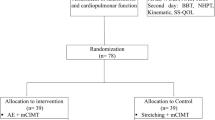Abstract
The main points of a treatment program for hemiplegic patients are: (1) prevention of disuse syndrome (strengthening muscles on the unaffected side, inducing frequent joint movement, providing strong sensory stimulation and walking training in the early stages); (2) treatment of paralysis and sensory impairment as well as higher brain dysfunctions (such as aphasia, hemi-spatial neglect); (3) training that includes gait training and ADL training. The actual components of treatment will differ depending on the patient’s age, duration after onset, severity of paralysis, severity of sensory disorder, muscle strength on the unaffected side and level of higher brain dysfunctions (Table 3.1). Physical therapy should place emphasis on the activities related to daily living and independent walking; therefore, it is essential to promote muscle strength in the unaffected limbs and trunk first. It will also be necessary to devote time to treatments that improve paralysis. Under the current medical insurance system in Japan, the time allotted for physical therapy and occupational therapy is about 20–60 min each. In order to provide an effective treatment that improves the patient’s paralysis, it is necessary to realize the intended movement within the limited treatment time and provide Repetitive Facilitative Exercise. Therefore, the technique for inducing excitement of the nerve tract should be completed within a few minutes. Instead of a conventional passive range of motion exercises, it (the range of motion exercises) is performed as a self-passive exercises with electrical and vibratory stimulation. This can be efficient as long as electrical and vibratory stimulation are not contraindicated, as described in the section on promotion methods in this book. (※ in Table 3.1).
Access this chapter
Tax calculation will be finalised at checkout
Purchases are for personal use only
Similar content being viewed by others
References
Ryu N. Nōsotchū kanja no shōgai no kōzō no kenkyū; henmahi to kikyo idō dōsa nōryoku no kaifuku katei no kenkyū [Structural disorder in patients with stroke; research on the process of recovery from hemiplegia and activities of daily living]. Sōgō Rehab. 1983;11:557–69.
Jørgensen HS, Nakayama H, Raaschou HO, et al. Outcome and time course of recovery in stroke. Part II: outcome. The Copenhagen stroke study. Arch Phys Med Rehabil. 1995;76:399–405.
Takuji H, Ishikawa S, Kawamura T, et al. Tsūsho rihabiritēshon ni okeru mansei-ki nōsotchū henmahi jōshi e no sokutsū hanpuku ryōhō to chiryō-teki denki shigeki shindō shigeki to no heiyō ni yoru mahi kaizen kōka [Effect of repetitive facilitation exercises with electrical and vibratory stimulation for chronic hemiplegia patients using day-care rehabilitation]. Physics Department. 2017;32:129–32.
Author information
Authors and Affiliations
Editor information
Editors and Affiliations
Rights and permissions
Copyright information
© 2022 The Author(s), under exclusive license to Springer Nature Singapore Pte Ltd.
About this chapter
Cite this chapter
Kawahira, K. (2022). Planning Treatment Program. In: Kawahira, K., Shimodozono, M., Noma, T. (eds) Exercise Therapy for Recovery from Hemiplegia. Springer, Singapore. https://doi.org/10.1007/978-981-19-0789-0_3
Download citation
DOI: https://doi.org/10.1007/978-981-19-0789-0_3
Published:
Publisher Name: Springer, Singapore
Print ISBN: 978-981-19-0788-3
Online ISBN: 978-981-19-0789-0
eBook Packages: MedicineMedicine (R0)




